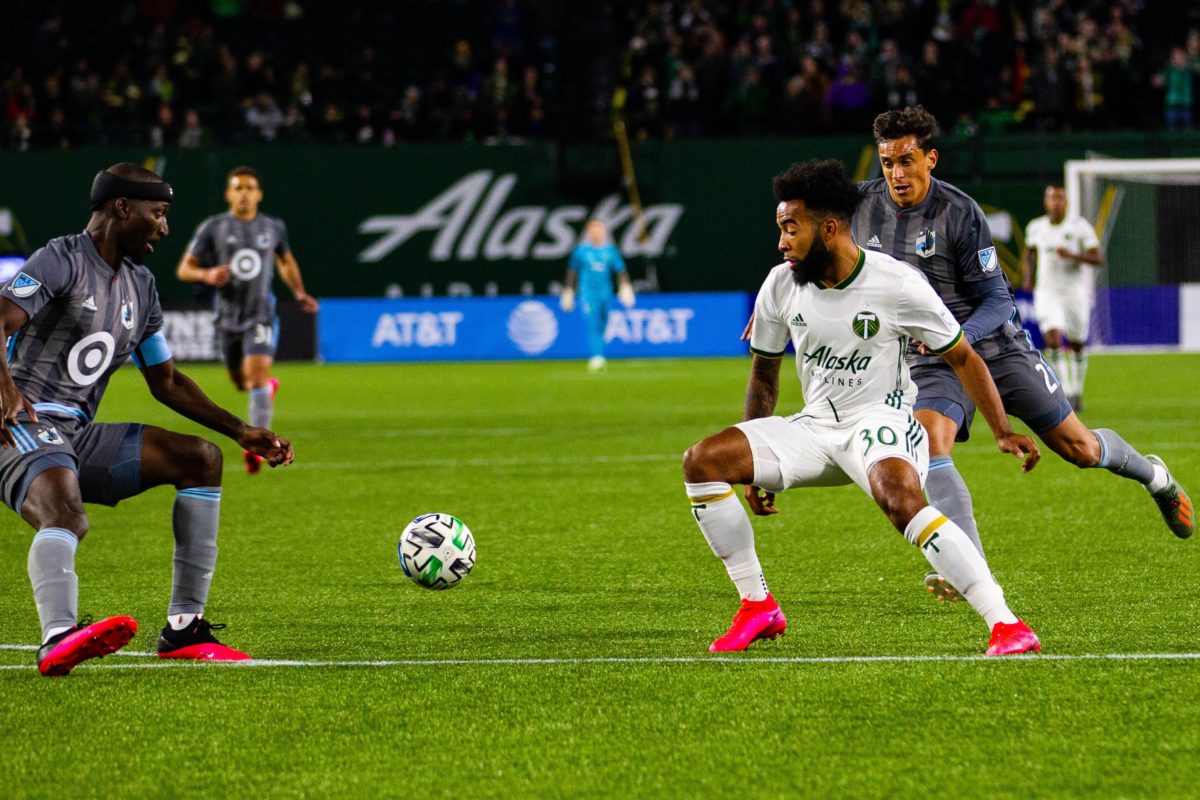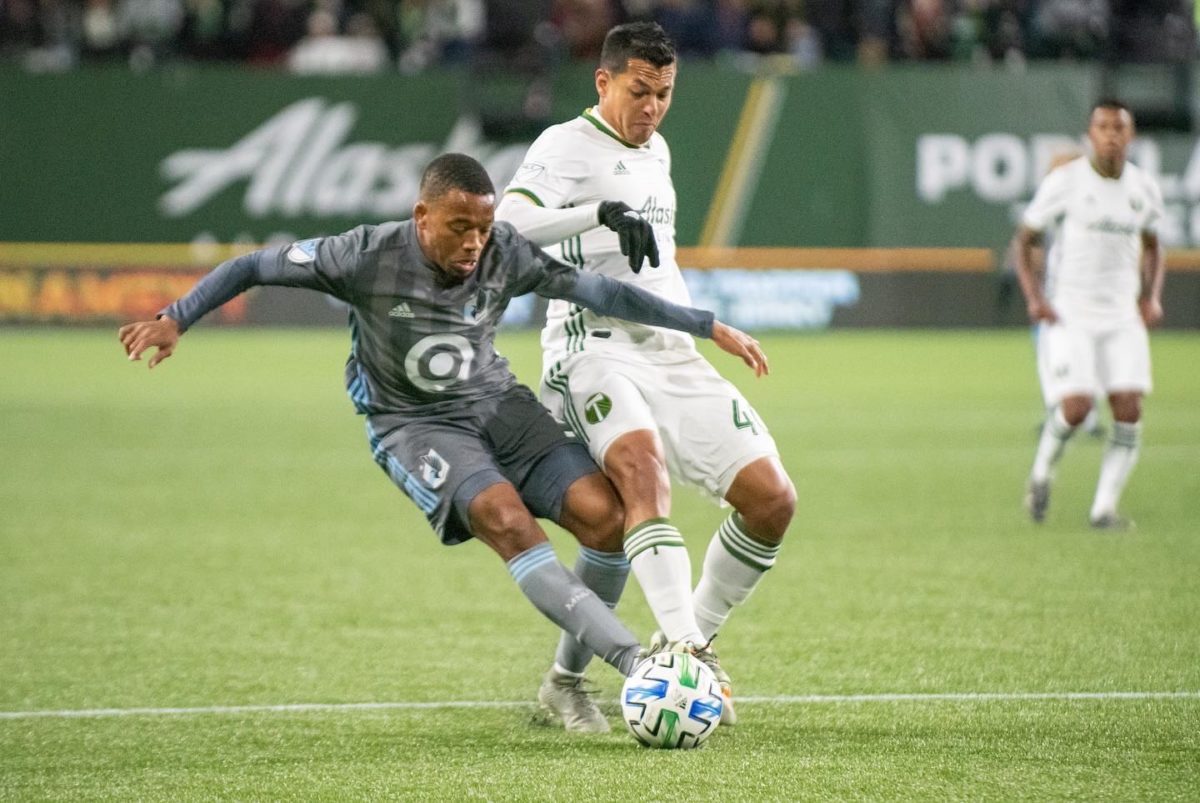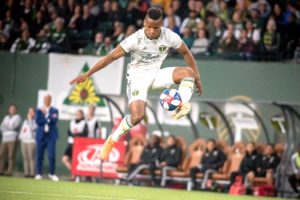To view this content, you must be a member of the Rose City Review Patreon at $2 or more
Already a qualifying Patreon member? Refresh to access this content.


Off the field, the USL Championship team will embrace a new identity, one with roots in Hillsboro. No longer will the team need to play in a cavernous Providence Park. Instead, games will take place 13 miles to the west in a new community. Playing at Hillsboro Stadium, there’s an opportunity for the team to create a new fanbase and set itself apart from the “older brother” MLS side, an opportunity to prove itself as a distinct, thriving piece of the organization.
This season, T2 could be more stable than ever before. The team plans to return many of last season’s mainstays, and there will be plenty of depth, which could help with the fluidity between T2 and the first team. However, change could also be in store for the months to come, as it’s possible the team could start the season with some moves yet to be completed. Head coach Cameron Knowles believes in the potential of his group and is excited to expose a new market to professional soccer, but also acknowledges that it is the organization’s responsibility to put forth a good product on the field and develop a fan base.
“With the move to Hillsboro, I think we should create some excitement in a new stadium with a new community,” Knowles said. “We’re going to have to have results on the field to do that, and we’re going to have to have engagement in the community off the field.”
What will not change is the team’s role within the organization. Situated in the second division of American soccer, T2 is the middle ground between the Timbers academy system and the first team. Ideally, it functions both as an incubator of talent and a development ground for players close to being able to contribute at the next level.
Last season saw players such as Marvin Loria and Renzo Zambrano make the leap from T2 to the first team, where they still play significant roles heading into the 2020 season. Before them, Jeremy Ebobisse had worked his way up the ladder from T2. Now, more young players than ever before are coming up through the Timbers’ academy system to play for T2, and in turn, more T2 players are beginning to make that leap to the first team.
Locally, Gio Calixtro (Cornelius) and Carlos Anguiano (Salem) are starting to make their way up the ranks. Over the offseason, T2 brought in Ken Krolicki from Montreal and Marcus Epps from Philadelphia, two promising young players with MLS experience already under their belt. Bringing in a youth international right back like Pablo Bonilla should go a long way as well. All of this comes before mentioning returning players like Ryan Sierakowski who will be playing closer to their natural positions this season.
“I think that it’s a pretty balanced group in terms of young, exciting talents, some local players that have come through our academy, and a couple of experienced players that come with experience outside of USL—with international experience or MLS experience,” Knowles said.
And while fans may be scrambling to identify the one or two obscure T2 names that could flash on the Providence Park reader board by the time the US Open Cup rolls around, maybe it’s worth looking at even younger names that are quickly making their way up from the academy. Knowles cited players like Southridge High School sophomore goalkeeper Hunter Sulte and Portland native Kevyn Lo as players worth watching this season.
As the year goes on, the team will continue to reevaluate these young academy players, assessing who deserves a look at the next level. According to Knowles, T2’s staff meets with the first team staff daily. With so much depth and talent in the player pool, these are exciting times within the organization. While not every player can follow in the steps of an Ebobisse, every year, there seems to be a player or two who makes some sort of breakthrough, and that seems likely to be the case once again this season.
Most importantly, the players themselves seem to be hungry to make the Timbers’ roster and prove that eventually, they can be first-team mainstays. This all bodes well in regards to T2’s season. Last year, T2 came out of the gate on fire before falling back to earth in the latter half. Knowles said that the organization has looked into last season’s disappointing finish, and that everyone wants to make sure the same thing doesn’t happen again. In the short term, he is hoping that the larger roster will add more depth and prevent the losses of momentum that can happen when a team is run-down and over-rotated by the middle of summer.
“The ultimate goal of being with T2 is to break through with the first team, so it was awesome to get that taste a little bit,” Sierakowski said. “Continuing to show my quality, continuing to show my presence by continuing to score goals and contributing in hopes of that translating to MLS.”
Added Anguiano: “I feel like I am in a good position and I need to make the most of the opportunity.”
Ultimately, the season’s results, both on and off the field, will come down to how well T2 can adapt to a new city while settling into another long, grueling USL season. The initial signs are positive, and according to those in and around the team, this season has the potential to be one of T2’s best.
Said Knowles: “Once we get two or three games into the season and the squad starts to settle down a little bit, I think we’ll get a sense of how competitive we can be in this league.”

Lately, I’ve been feeling like 2020 might actually be kind of cool and that weird sense of optimism has extended to my thoughts about the Timbers. So after watching the preseason tournament and then actually thinking about the things that I saw, I’ve put together a few points that I predict will be true about the Timbers this year.
This dude is just so good, I literally could not keep my jaw off the floor while watching him in the preseason. He’s silky on the ball, his passing is incisive, and he’s pretty good at knowing where to stand, too. With
Tomás Conechny playing more of his minutes out on the wing these days, it seems like Williamson is poised to get a healthy number of minutes as the third (or maybe second, depending on where
Sebastián Blanco is playing) No. 10 in the depth chart. And that’s in part because…
Don’t get me wrong. Valeri is still an incredible player and an 8 goal, 16 assist 2019 season is nothing to scoff at. That said, Valeri also showed some major signs of slowing down last year, and unfortunately for Portland; time’s arrow neither stands still nor reverses, it merely marches forward. Combine what will likely be a physical need to play fewer minutes with no longer being on a designated player contract and it’s not a stretch of the imagination to envision a Valeri that plays closer to 2000 minutes in 2020 than the 2600 minutes he played in 2019. With that in mind…
When Diego Valeri is on the field, it’s basically mandatory to play a shape that utilizes a true No. 10. That’s (one reason) why it has made sense for the Timbers to play a diamond midfield when they’ve wanted two strikers on the pitch over the last couple of years. But, as mentioned above, there will almost certainly be times this year where that is not the case.
What the Timbers do have this year is two DP wingers, one DP striker, and two other good to very good strikers. So, imagine a flat 4-4-2 formation with Ebobisse’s hold-up play filling the creative role in the center of the park, and Niezgoda, Blanco, and Y. Chara all running off of him. If I was an opposing defender, that thought might just keep me up at night.
Everyone knows the Timbers are always bad in March (with the notable exception of 2017 (see below)). In fact, across all MLS regular season matches played in March, the Timbers average an abysmal .85 points per game. It (somehow) gets even worse if we look specifically at the Savarese era, as Gio has only managed to pick up three points in eight March games. That’s .38 points per game.
But this year, I think, will be different. This may be a bold claim, because admittedly, what we saw defensively over the last two preseason matches was, well, not good. However, we also saw a hungry, attacking mentality, and I have a feeling that this team is going to want to make up for the lackluster finish to 2019. The Timbers have five matches this March: Minnesota(Home), Nashville (H), New England(Away), LAFC(A), and Philadelphia(H). My money’s on ten points out of that slate.

The bright sun peeked out through the fog on another cold Pacific Northwest morning as the Portland Timbers’ first team entered the pitch for another day of training. On the outskirts of the field were the goalkeepers, already multiple drills into their practice. Field players were beginning to stretch on the opposite side of the field.
A few feet away from all of this is a fence, teasingly covered in black and tall enough to obscure any passersby from sneaking a peek directly at the practice field. On the other side of this fence is another pitch—that one, tantalizingly close, yet a world away, is where many young players begin their professional journeys for Timbers 2 (T2). This less-secluded field is where players continue their development, with the ultimate goal of becoming permanent fixtures at the practice field across the fence.
It’s been six years since T2 started, and as time has gone on, more and more players are beginning to make that very jump. Two seasons ago, forward Jeremy Ebobisse made the leap from the USL Championship side to the first team; last season, Marvin Loria, Eryk Williamson, and Renzo Zambrano followed. What makes T2 pivotal for player development is that the program is connected to the first team, allowing players to make the transition from the development academy or college to the professional level.
For Zambrano, a Venezuelan who had only played in Spanish-speaking countries, being a part of T2 allowed him to adjust to living in America and gain more confidence in himself as a player, all while receiving multiple opportunities to play game minutes.
“When I came from Spain, I had an injury,” Zambrano said, mostly in English with a little help of a translator. “So my focus was playing every single week in as many minutes as I could. The confidence the coaches gave me to be able to play, develop, and eventually make it to the first team was key.”
During May of last season, Zambrano received his first opportunity to play with the Timbers. Shortly after playing the Tacoma Defiance in the USL, Zambrano remembers being told by the coaching staff that he would be getting to start in a regular-season mid-week match against the Houston Dynamo.
“I prepared for that moment and worked very hard, because this is a very competitive squad and there are many players who want to be stars,” Zambrano said. “Obviously I knew that I had to take advantage of that opportunity and do the best I can, both in training and also in the games.”
While Zambrano needed to adapt to a whole new country, culture, and language; Williamson—a Virginia native—recalls the helpfulness of just having a designated place to develop and get minutes before making the jump to MLS.
“Right away, I learned what do I have to get out of a professional game, what do I have to do for ninety minutes, what do I have to do for the time I’m stepping on the field,” Williamson said. “I think that’s the biggest thing that I take from T2 games. Making sure that I am getting my job done, so when it is time to make that step, it’s repetition.”

Unlike most of the USL Championship, T2 is directly tied to an MLS side. Having that in Portland allows players and coaches at all levels of the organization to interact. Sometimes that interaction takes place in the cafeteria; other times, a first-team player might check out a game or training of the USL side.
“It’s pretty cool when they come say ‘Hi’ to you and ask you how you’re doing,” current T2 midfielder Carlos Anguiano said with a smile.
The close relationship between the two branches of the club benefited Williamson, who has been working closely with the Timbers’ video and data analyst, Shannon Murray, and assistant coach Miles Joseph over the past few years. The three often sit down and go over film. Williamson learns more about what the first team coaches want to see out of him, which helps him shape his game in the right direction.
Last June, the fitness staff advised Williamson to be ready in case he was needed on the first team, who were finishing up a hectic, road-heavy start to the season. A few days later, head coach Giovanni Savarese told him that he was going to start in the team’s mid-week match in Montreal, a testament to his hard work and performance for T2.
Yet, for as beneficial as T2 can be—and that’s the consensus—sometimes being a part of the second team is difficult for players, especially mentally. One player with mixed emotions from his time on T2 is current first-team striker Jeremy Ebobisse. Ebobisse, it can be argued, is the most successful player to come out of T2—he recently signed a contract extension with the first team—but his time in the USL was tumultuous.
In his first season with T2, Ebobisse played three games before being called up to the first team, where he trained but often sat on the bench during games. Later that season, he played in the US U-20 World Cup and returned only to play in a handful of T2’s remaining games.
“That [apparent] regression was challenging mentally, but ultimately going to play with T2 taught me that there’s a lot of responsibility on players that the club views as first-team guys for the future,” Ebobisse said. “If you do not live up to the standard of raising everyone else’s level, then ultimately you’re going to face consequences, and I faced probably the hardest and worst consequences where I found myself on the bench for T2 my second year right before breaking through. I think there are some hard lessons to learn, but through it all, it’s a unique place to have to grow. Obviously, you hope to bypass it, but if you have to spend a year or two there are lessons you can take out of it.”

An in-form start to the 2018 season was quickly derailed by multiple injuries, call-ups, and time on the bench, which made it almost impossible to establish any type of consistency until the season’s latter half. Coming into the organization with high expectations of himself, Ebobisse found the proximity to the first team more mentally challenging than he anticipated.
“This is just my personal opinion, but it’s almost detrimental to a player’s well-being if they are not mentally strong enough in that moment to know that there is a barrier separating where they belong, and the guys they see and train with most of the time and where they’re at,” Ebobisse said. “So when I am on the turf training for T2 and I see the first team having a competitive training and competing and laughing and yelling, I want to be a part of that. Sometimes adjusting to that position is challenging as well.”
But in a way, it was that proximity to the first team that ultimately benefited him. Ebobisse made some close friends in the Timbers locker room who continued to encourage him and helped him stay mentally engaged during the tough moments. In fact, it was Larrys Mabiala and Bill Tuiloma who told Ebobisse he would be getting his first regular-season start.
“I was at the stadium training, they saw the practice scheme and said ‘You’re starting this weekend, you better be ready. Are you ready?’ while laughing,” Ebobisse recalled. “I said ‘What are you guys talking about,’ and tried to downplay it in the moment like it’s another training.”
“Knowing that you have guys in your corner,” Ebobisse continued. “Mabiala was on the field with me that game and I think he was as happy that I scored in that game against Colorado as I was. Just surrounding yourself with good people is always really important.”
While it was a challenging couple of seasons for Ebobisse, the young American now plays consistently for the Timbers every weekend. Zambrano took advantage of his opportunity at T2 and is beginning to cement himself as a solid rotation player in the midfield. And while Williamson is still in between T2 and the first team, he believes that he is close to his breakthrough.
For some players it is motivating whereas for others it is more challenging, but being a part of T2 has ultimately helped every player that has come through in different ways. Every T2 player dreams of someday taking that next step. One day, the hope is, they’ll move to the other side of that fence, symbolizing the transition from the second division of American soccer to the first.
“It’s definitely motivating,” Ryan Sierakowski said of his aspirations. “It’s in reach, it’s right there, you can feel how close it is. It’s motivating to know that having a good run of games and showing your quality you can be called up at any time.”